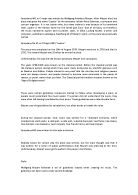The second strings are very limited in the amount of new melodic material that they provide the movement. An example of where they do play when the first violins are not adding new material is in bar 39, in which a short four-quaver pattern is played emphasizing the third and fifth of the chord G (the dominant) as the cello and bass play a tonic pedal note. Here the first violins have as much melodic importance as the rest of the string section and are simply limited to playing the chordal and harmonic backing.
In general, the first and second violins play in harmony with each other, the first violins providing the lead and the second violins the accompanying harmony lines, usually a third apart.
The viola and the cello/bass have a similar relationship as the first and second violins. They often play in harmony or unison, and play the same melodic material. An example of where the violas play additional and separate material from the cello/bass is in bar 150-156, where the bass section does not play anything and the violas fill in the gaps left by the bass section.
In general, because of the high melodic and harmonic importance of the strings, they play throughout most of the movement. However, there are brief sections in which the strings have a less important role (such as in the second subject). They do play throughout the entire movement and are never left out entirely.
The woodwind (also known as double woodwind) have a more prominent role in this symphony than in similar symphonies and orchestral pieces of the time; this is a key factor in Beethoven’s influence over music at the time and the eventual musical progression from classical to more romantic music. Also, the introduction of more prominent use of clarinet was a bold and new idea because it was not used very often during the classical period, due to it being a fairly new instrument.
The clarinets are still however generally used in a harmonic manner, much like the viola and cello/bass section of the strings. The flutes and oboes, on the other hand (as was more typical of the time period in which the piece was written) have more “melodic value” as it were; although they have nowhere near the amount of melodic importance as the first violins, together they arguably constitute the second most important melodic instruments in the symphony.
The bassoons have a wide range, and Beethoven takes advantage of this throughout the movement, for example in bars 59-61- here they have a range of a 14th, playing from a low B in the bass to the G above middle C. They do not, however, have any really significant melodic material in general, unlike the flutes and the oboes, and perhaps to a lesser extent the clarinets.
Hence melodic material is mainly shared amongst the flutes and oboes, with the bassoons and clarinets having less of an important role.
The Brass section consists of valveless, natural instruments (2 horns in C and F and 2 trumpets) that are mainly used to strengthen cadence points (essentially through the use of tonic and dominant notes). An example of where they are used for this purpose is bar 76.
Because they cannot play more remote keys, the sections in which remoter keys are used are quieter. They are intended for use to best effect in their harmonic series using mainly the tonic and dominant, and therefore when the movement modulates to other keys these notes have less harmonic significance and hence the horns are used less.
The horns and trumpets tend to play together much of the time. The horns are about the same register as the clarinets and fill in the middle block of the harmony.
Finally, the percussion section consists solely of the timpani’s. During this time the timpani’s were tuned by hand and hence changing the tuning was time consuming and largely unheard of. The two timpani’s are tuned to the tonic and dominant (this is also the reason why in the second movement they are not used much because it is in a separate key) and hence are often used to much the same effect as the brass section – to strengthen cadence points. Two examples of this are in bars 260 and 274. As loud instruments, they are basically only used in forte or fortissimo.
By Daniel Goode
27th November 2012








